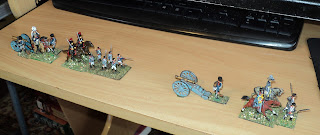Well, just about every war gamer - just about every collector of any kind - promises to do this, don't they? To draw a line under their inventory. No more to be added.
 |
| Perry figures, painted as the Tartar regiment of uhlans. |
So, with this unit of Russian Uhlans - 28mm Perry Plastics - I have 'drawn a line' beneath my Napoleonics. I have plenty for my needs even though I have focused upon the main players, and much less so upon their allies. Possibly with a bit more thought, I would have fewer French and more - that is to say, something - in the way of Italians, Swiss, Bavarians, Saxons, Westphalians and Poles. I have none of them. though a unit of Nassauers somehow insinuated itself into my collection...
 |
| The white contrasts nicely with the dark red and even darker blue of the uniforms. |
But with somewhere in the region of 2400 figures overall, most of them metal, I reckon that will have to do. Here's a rough count:
- French: 750 figures, 12-14 cannon
- Austrian: 650, 10 cannon
- Russian: 300, 6 cannon
- Prussian: 330, 6 cannon
- British: 250, 5 cannon
- Brunswick: 50 (horse and foot)
- Nassau: 30
- Portugal: 20
- Spain: 20
Not the biggest collection in the world - not even the biggest amongst my limited acquaintance - but still a fairish number. That is plenty for a whole war with my Big Battles for Small Tables game system - even more so if using Bob Cordery's Portable Wargames. Of course, if at the next Bring-n-Buy at the club, something grabs me by the throat and says 'buy me, or else!' then I might be forced to rethink...
 |
| Still a little bit of work to do on these, but I quite like the look already. |
Now, there were 14 figures in the Perry box. A 14-figure unit - 2 more than my standard 12-figures for cavalry? I do have as small number whose strengths vary from that standard. Or detach a couple as General Officer escorts? Decisions, decisions...








.jpg)